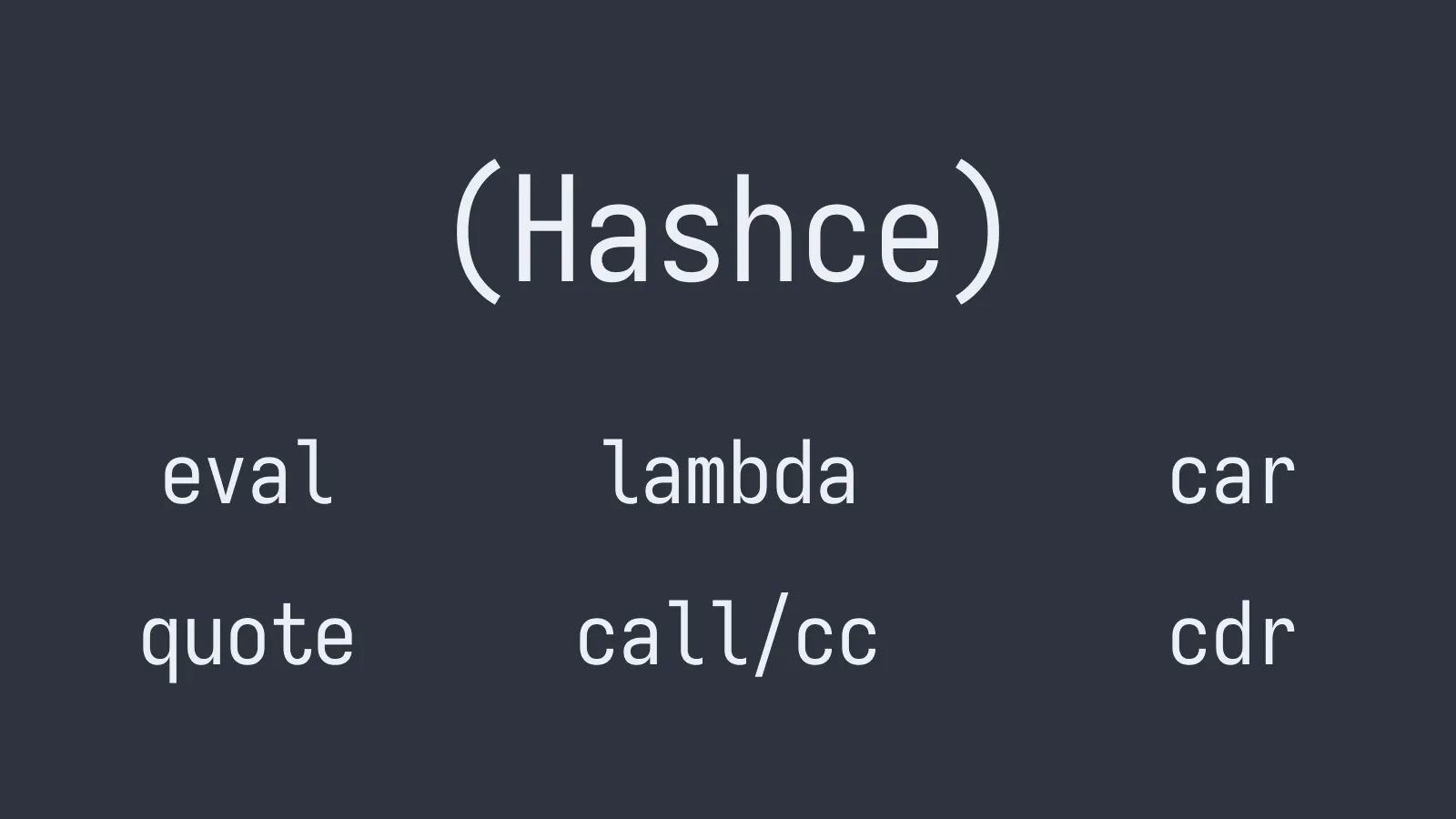Hasche
A Scheme-like language interpreter written in Haskell

Hasche (/hæʃ/): Haskell + Scheme
Hasche is a toy interpreter for a Scheme-like language, written in Haskell. It features a REPL, pattern-matching, non-hygienic macros, call/cc and first-class continuations.
Contents
Try It out!
Cabal is required to build Hasche.
git clone https://github.com/wasabi315/Hasche.git
cd Hasche
cabal buildThe exec command is to execute a Scheme file.
$ cabal exec hasche -- exec ./programs/hello.scm
Hello, world!Hit the repl command to start a new REPL session and try Hasche interactively.
$ cabal exec hasche -- repl
Welcome to the Hasche REPL!
enter :? for help
hasche> (+ 1 1)
2
hasche> (display "Hello, world!\n")
Hello, world!Features
Pattern matching
Pattern matching is one of the common features in functional programming languages, so why not in Hasche?
Use the match special form to perform pattern matching.
(define nested-data '((1 2 3) (4 5 6)))
; displays 1
(match nested-data
[((m . _) (4 5 6))
(begin (display m) (newline))]
[_
(display "Failed to match\n")])Hasche has two a bit unusual patterns: predicate patterns and rest patterns.
A predicate pattern is of the form (? <predicate>). It matches if the predicate returns #t for the scrutinee (the value being matched). Predicate patterns can be sub-patterns, unlike Haskell’s pattern guards or OCaml’s when guards.
(define nested-data '((1 2 3) (4 5 6)))
; displays "m is not 0" as (zero? 2) is #f
(match nested-data
[((_ (? zero?) _) . _)
(display "m is 0\n")]
[_
(display "m is not 0\n")])A rest pattern is of the form (<pattern> ...). It matches if the given pattern matches all elements of the scrutinee. If the pattern contains variable patterns, the lists of the corresponding elements are bound to the variable. In the example below, pattern matching succeeds since all elements of nested-data are lists of three elements. The lists of the first, second, and third elements of nested-data are bound to m, n, and o, respectively.
(define nested-data '((1 2 3) (4 5 6)))
(match nested-data
[((m n o) ...)
(begin
(display m) (newline) ; displays (1 4)
(display n) (newline) ; displays (2 5)
(display o) (newline))]) ; displays (3 6)Of course, rest patterns can also be nested.
(define nested-data2 '(((1 2) (3 4)) ((5 6) (7 8) (9 10))))
(match nested-data2
[(((m n) ...) ...)
(begin
(display m) (newline) ; displays ((1 3) (5 7 9))
(display n) (newline))]) ; displays ((2 4) (6 8 10))Non-hygienic macros
Hasche supports macros via the define-macro special form, which uses the same syntax as define.
Unlike procedures created with define that operate on values, macros defined with define-macro receive programs as lists and return a new program (also as a list) to be evaluated. For example, the following and macro expands to a sequence of if expressions.
(define-macro (and . l)
(match l
(() #t)
((test1 . test2) `(if ,test1 (and ,@test2) #f))))
; (and t1 t2 t3)
; => (if t1 (and t2 t3) #f)
; => (if t1 (if t2 (and t3) #f) #f)
; => (if t1 (if t2 (if t3 (and) #f) #f) #f)
; => (if t1 (if t2 (if t3 #t #f) #f) #f)
(and t1 t2 t3)Here ` (quasiquote), , (unquote), and ,@ (unquote-splicing) are used. Quasiquote is like quote, but it allows interpolation using unquote and unquote-splicing.
In fact, special forms such as begin, let, and cond are not built into the interpreter; they are implemented as macros in the standard library.
Thanks to the match and quasiquote, they can be implemented concisely.
; In lib/stdlib.scm
(define-macro (cond . clauses)
(match clauses
[()
(error "cond with no arms")]
[(('else body ...))
`(begin ,@body)]
[((pred body ...))
`(if ,pred (begin ,@body))]
[(('else _ ...) _ ...)
(error "else is not allowed here")]
[((pred body ...) rest ...)
`(if ,pred (begin ,@body) (cond ,@rest))]
[_
(error "invalid cond syntax")]))Hasche’s macros are non-hygienic, meaning that they do not perform variable capture avoidance.
We can use gensym to generate a unique symbol and avoid variable capture.
(define-macro (incr v)
`(let ([x 1]) (set! ,v (+ ,v 1))))
(define x 0)
; expands to (let ([x 1]) (set! x (+ x 1))), making x shadowed!
(incr x)
(display x) (newline) ; displays 0
(define-macro (incr2 v)
`(let ([,(gensym) 1]) (set! ,v (+ ,v 1))))
(incr2 x) ; x is not shadowed this time
(display x) (newline) ; displays 1call/cc and first-class continuations
One of Scheme’s most distinctive features is the call/cc procedure (call-with-current-continuation). It is incredibly powerful for implementing control flow constructs such as exceptions and generators.
call/cc captures the current continuation (the surrounding context of the call/cc call) and passes it to the given procedure.
The continuation can then be resumed by invoking it with an argument.
In the example below, the surrounding context (display ...) is bound to the k parameter and then called with 1, producing the output 1. We can observe that (+ ... 2), the continuation of (k 1), is abandoned.
hasche> (display (call/cc (lambda (k) (+ (k 1) 2))))
1Continuations are first-class in Hasche; they can be passed to and returned from procedures and even stored in data structures.
hasche> (define save '())
hasche> (display (call/cc (lambda (k) (set! save k)))) ; (display ...) is bound to save
#<undef>
hasche> save
#<continuation>
hasche> (save 1)
1
hasche> (save 2)
2
hasche> (save 3)
3Implementation highlights
Hasche uses a simple tree-walking interpretation approach.
The evaluator is implemented using the monad transformer stack ReaderT Env (ContT r IO).
As the monad stack includes ContT, the call/cc procedure can be implemented straightforwardly.